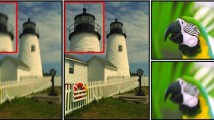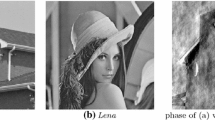Abstract
Blind deconvolution problems arise in many image restoration applications. Most available blind deconvolution methods are iterative. Recently, Justen and Ramlau proposed a novel non-iterative blind deconvolution method. The method was derived under the assumption of periodic boundary conditions. These boundary conditions may introduce oscillatory artifacts into the computed restoration. We describe extensions of the Justen–Ramlau method that allow the use of Neumann and antireflective boundary conditions.
Similar content being viewed by others
References
Aricò, A., Donatelli, M., Nagy, J., Serra-Capizzano, S.: The anti-reflective transform and regularization by filtering. In: Bhattacharyya, S., Chan, R., Van Dooren, P., Olshevsky, V., Routray, A. (eds.) Numerical Linear Algebra in Signals, Systems, and Control. Lecture Notes in Electrical Engineering, vol. 80, pp. 1–21. Springer, New York (2012)
Ayers, G.R., Dainty, J.C.: Iterative blind deconvolution method and its application. Opt. Lett. 13, 547–549 (1988)
Campisi, P., Egiazarian, K. (eds.): Blind Deconvolution. Theory and Applications. CRC Press (2007)
Carasso, A.S.: False characteristic functions other pathologies in variational blind deconvolution. A method of recovery. SIAM J. Appl. Math. 70, 1097–1119 (2009)
Chan, T.F.,Wong, C.K.: Total variation blind deconvolution. IEEE Trans. Image Process. 7, 370–375 (1998)
Chan, T.F., Wong, C.K.: Convergence of the alternating minimization algorithm for blind deconvolution. Linear Algebra Appl. 316, 259–285 (2000)
Fan, Y.-W., Nagy, J.G.: An efficient computational approach for multiframe blind deconvolution. J. Comput. Appl. Math. 236, 2112–2125 (2012)
Hansen, P.C., Nagy, J.G., O’Leary, D.P.: Deblurring Images: Matrices, Spectra, and Filtering. SIAM, Philadelphia (2006)
He, L., Marquina, A., Osher, S.J.: Blind deconvolution using TV regularization and Bregman iteration. Int. J. Imaging Syst. Technol. 15, 74–83 (2005)
Horn, R.A., Johnson, C.R.: Topics in Matrix Analysis. Cambridge University Press, Cambridge (1991)
Ji, H., Li, J., Shen, Z., Wang, K.: Image deconvolution using a characterization of sharp images in wavelet domain. Appl. Comput. Harmon. Anal. 32, 295–304 (2012)
Justen, L., Ramlau, R.: A non-iterative regularization approach to blind deconvolution. Inverse Probl. 22, 771–800 (2006)
Levin, A., Weiss, Y., Durand, F., Freeman, W.T.: Understanding and evaluating blind deconvolution algorithms. Proc. IEEE Conference on Computer Vision and Pattern Recognition, pp. 1964–1971. IEEE, CVPR (2009)
Liao, B.H., Ng, M.: Blind deconvolution using generalized cross validation approach to regularization parameter estimation. IEEE Trans. Image Process. 21, 562–572 (2012)
Molina, R., Mateos, J., Katsaggelo, A.K.: Blind deconvolution using a variational approach to parameter, image, and blur estimation. IEEE Trans. Image Process. 15, 3715–3727 (2006)
Ng, M., Chan, R., Tang, W.-C.: A fast algorithm for deblurring models with Neumann boundary conditions. SIAM J. Sci. Comput. 21, 851–866 (1999)
Ng, M.K., Plemmons, R.: Blind deconvolution and structured matrix computations with applications to array imaging. In: Campisi, P. (ed.) Blind Deconvolution: Theory and Applications, pp. 377–418. CRC Press, Egiazarian, K. (2007)
Ng, M.K., Plemmons, R., Qiao, S.: Regularization of RIF blind image deconvolution. IEEE Trans. Image Process. 9, 1130–1134 (2000)
Serra-Capizzano, S.: A note on antireflective boundary conditions and fast deblurring models. SIAM J. Sci. Comput. 25, 1307–1325 (2003)
Spaletta, G., Caucci, L.: Constrained iterations for blind deconvolution and convexity issues. J. Comput. Appl. Math. 197, 29–43 (2006)
Author information
Authors and Affiliations
Corresponding author
Additional information
Research by L. Reichel was supported in part by NSF grant DMS-1115385.
Rights and permissions
About this article
Cite this article
Hearn, T.A., Reichel, L. Extensions of the Justen–Ramlau blind deconvolution method. Adv Comput Math 39, 465–491 (2013). https://doi.org/10.1007/s10444-012-9290-z
Received:
Accepted:
Published:
Issue Date:
DOI: https://doi.org/10.1007/s10444-012-9290-z




